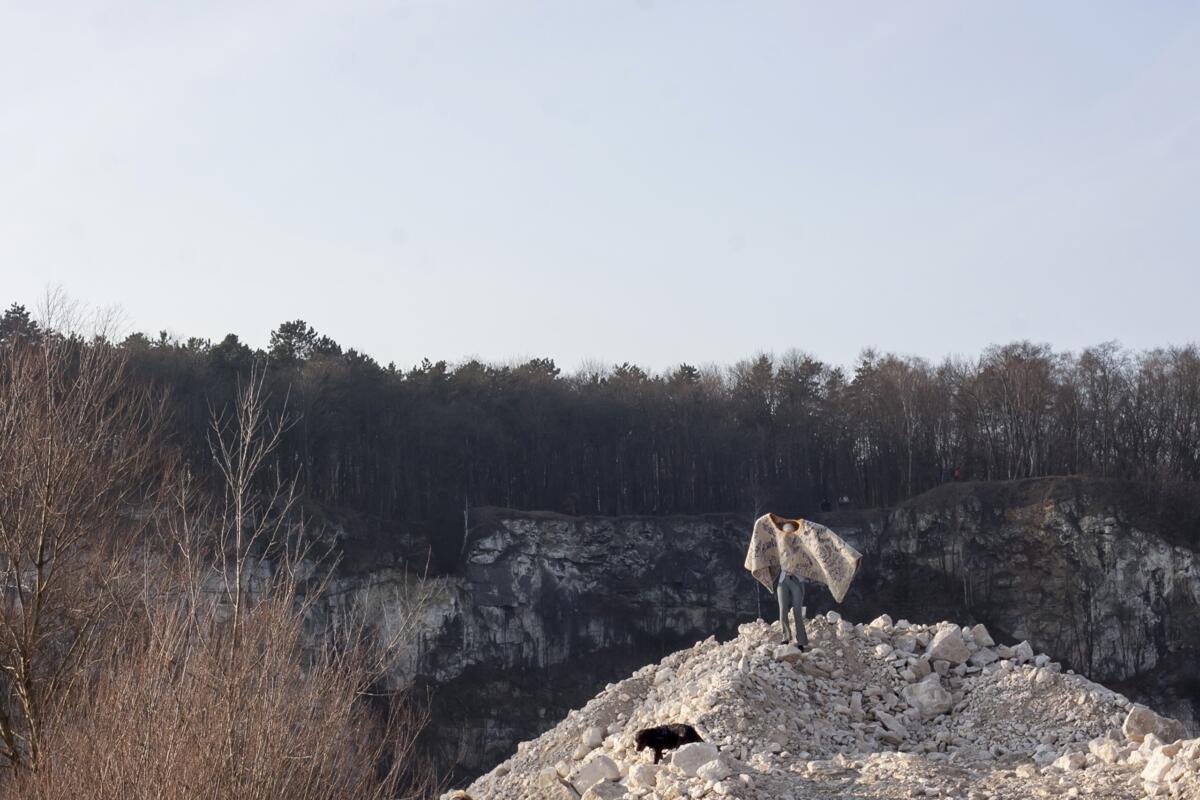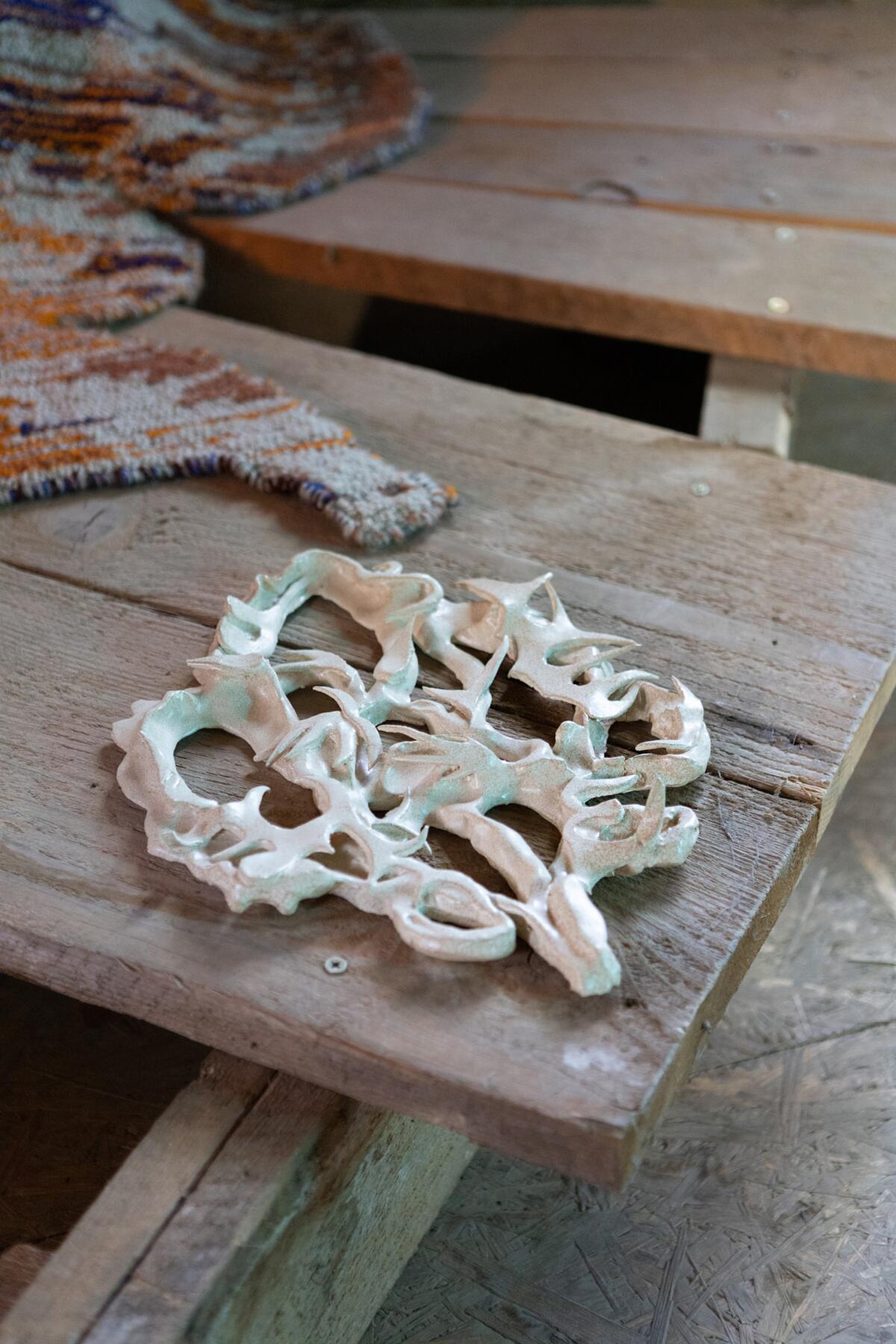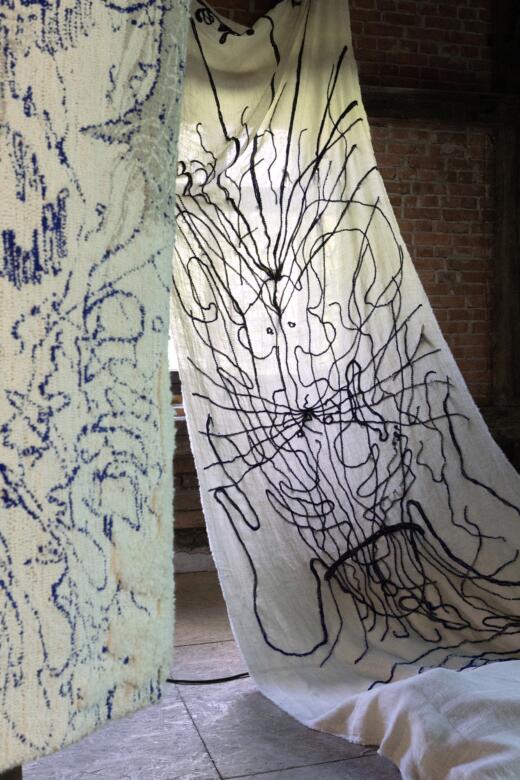
Arkadiusz Półtorak: Your doctoral project, the results of which you present at the exhibition, bears the full title Some Holes in this House. Exercises in Expanding and Narrowing the Field of Comfort. How do you understand the phrase “exercises” in the context of your practice?
Marta Niedbał: “Exercise,” to me, means getting skilled at something, though not necessarily with the goal of achieving mastery – or even any particular goal in mind. It can even refer to a process of unlearning – moving into a space where easy answers or habits are hard to develop. “Exercise” might well mean free exploration, dispersal of energy, looking in the dark… In my practice I often move between different media and themes, and I don’t associate the “art-making” with any particular activity. I read a lot in the studio, but I also often focus on bodily exercises. Besides, much of my practice develops outside the studio.
Arkadiusz: What kind of bodily exercises do you include in its context?
Marta: Walks, for example, where I also “take my fabrics out”. Even before such outings became a form of public performance, I took one of my works for a walk with my boyfriend – just like that, without any particular intention. We lay on it, took some photos… And although at the time I was not thinking of conceiving an organised form of action, months later I realised that those walks had already been vital for the development of my practice. Playing with accidental circumstances and openness to interaction with others are important aspects of my ‘exercises’.
Arkadiusz: I thought the primary bodily exercise within your practice was weaving.
Marta: Not really… Although large works can indeed be tiring. Their weaving is accompanied by a lot of repetitive, even ritualistic activities – and I actually care more about their course than about the final effect.
Arkadiusz: But you are not a conceptualist in the style of Richard Serra who used to label his works with verbs defining the way they were created, like “to splash”, “to cast” etc.
Marta: As well as the actions I perform in the studio, the actions that determine the life of my already-finished works are equally important to me. I don’t fetishize gesture, at least not my own. I am very interested in the movements made towards and around my work by others. Sometimes it is thanks to them that I notice lines of affinity between certain works – and they are so strong that I later decide to include the pieces in a series. When creating new objects, I reserve the right to suspend all attempts at naming and interpreting them until they “find” a suitable context for themselves. Maybe it is a bit naive, but…
Arkadiusz: But it stems from a sensitivity to context, I suppose?
Marta: Exactly, yes. The context is very important to me.
Arkadiusz: What contexts should viewers of the exhibition at the Elementary know about?
Marta: The appearance of these works was determined by many factors, largely private – such as the aforementioned walks or meetings with loved ones. Or dreams… My works such as Tender Demonesses or Bestiala are like hybrid creatures “entangled” in feminine narrativity and complex, unstable relationships with the body and its sensual leaks. I would like the exhibition space to invite everyone to participate in an intimate relationship with a world that is full of stumbling blocks, holes and understatements. While working on the series shown at Elementarz, I was immersed in various readings, for example in the field of ecology. A term that caught my attention was “ecotone”, which means a transition zone between different ecosystems – such as an unploughed ridge. Ecotones are among the most mobile and changeable features of the landscape, and are often so fluid that grasping their essence becomes nearly impossible. They are places that occupy the zone between ‘no longer’ and ‘not yet’. The studio itself, where I work, seemed to be such a zone. As I’ve already mentioned, many of the activities I do there are not directly related to art-making, but somehow influence it. Seemingly banal, sometimes routine – lurking forces of chaos.
Arkadiusz: I remember that when I visited you in your atelier for the first time, we talked about Jolanta Brach-Czaina and her philosophical praise of chores.
Marta: That’s it. Her Szczeliny istnienia (Cracks of Existence) – this great praise of everyday things and activities – is a very important book for me. By the way, it’s possible that if it weren’t for my daily chores, I wouldn’t have come up with the idea of taking up textile work seriously. Since the particular pieces we are showing at Elementarz have already left the studio, I am counting on others to spend the next few months loitering around them and putting them into new contexts.
I invite the visitors into the space of the leaky “house” in transit, where everyone is free to become a resident – not just a spectator. Quietly whisper the demonesses that to inhabit the world – and not just to occupy it – is to live in an open, unsealed space. “He who is born must emerge or perish”. I am keen to strip at least some of the fabrics of their aura of individual, “sacred” works – so that visitors to the gallery can sit on them while talking to loved ones, listening to music or a lecture. I can only hope that the conversations around the works will be as affirmative and close to nature as the circumstances surrounding the creation of some of the works.
Arkadiusz: So let’s count on a kairos!
Edited by Ewa Borysiewicz and Katie Zazenski



Marta Niedbał – Artist living and working in Kraków. Graduated from the Academy of Fine Arts in Krakow and completed a scholarship at the London College of Communication. Her practice is based on proximity and attentive listening. The works reflect the flows between everyday life and the widely understood field of art, emphasising the role of space in the discussion on new forms of solidarity, empathy and being together.
Selected exhibitons: Interior (BWA Katowice, 2022), Farmaceutka (MM Tychy, 2022), Sabat (Galeria Podbrzezie, Kraków, 2021), Liste Art Basel (Galeria Serce Człowieka, Bazylea 2021), Salon odnowy magicznej (Galeria Widna, Kraków, 2021), Somnium Soft–Core (Galeria Czwartek, Warszawa, 2021), Young Trapped (Galeria Serce Człowieka, Kraków, 2021), SNY: Skutki pandemii (Galeria Serce Człowieka / na Warsaw Gallery Weekend, 2020), A Dream within a Dream (Dzidy Duo Garden, 2020), Ognisko domowe (Galeria Śmierć Człowieka, Warszawa, 2019).
The exhibition is part of Niedbał’s doctoral project entitled: Some Holes in This House. Exercises in Widening and Narrowing the Field of Comfort, completed in the Faculty of Art, Pedagogical University in Krakow.
Accompanying audio-performance: Charlie (Leona Jacewska)
Part of: KRAKERS Cracow Art Week 2022
Imprint
| Artist | Marta Niedbał |
| Exhibition | Some Holes in This House |
| Place / venue | Elementarz dla Mieszkańców Miast |
| Dates | 12.06.2022-20.08.2022 |
| Curated by | Arkadiusz Półtorak |
| Index | Arkadiusz Półtorak Elementarz dla Mieszkańców Miast Marta Niedbał |


